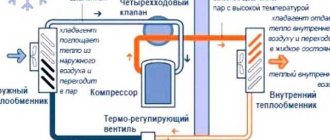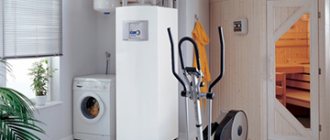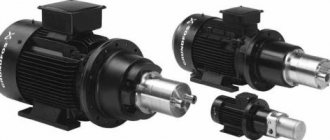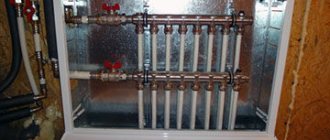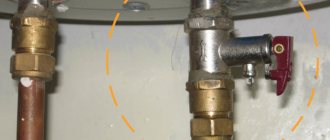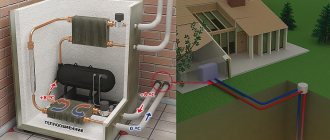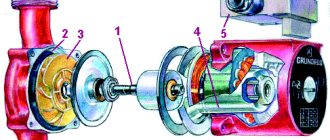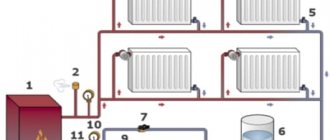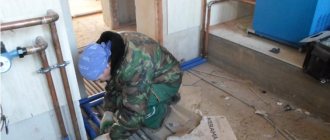In winter, a country house must be heated even in the absence of the owners. The problem of heating a cottage far from the gas distribution network often becomes an insurmountable obstacle to life on earth. Heating with electricity is too expensive even for a wealthy person, and hiring an outsider to stoke a wood or coal stove is risky. The most progressive solution to this problem is heating using a geothermal heat pump (GHP).
What is a geothermal heat pump
Planetary energy can be used on any part of the earth. Geothermal springs with boiling water bubble up only where hot magma comes close to the surface. In the rest of the space, heat from the center of the Earth is distributed evenly. Therefore, at a depth below the soil freezing level, the same temperature is maintained year-round.
The purpose of the HHP is to pump heat from the soil or reservoir into the house. Energy is collected from the surrounding area by pipes, and then a compressor heats the water for the heating system of the cottage. Therefore, from 1 kW of electricity spent, 3-5 kW of heat is obtained.
Device
For the gas turbine to operate, three independent systems are required: intra-house, compressor, and external circuits. They are combined into one circuit by heat exchangers in which various coolants circulate.
The gas turbine unit consists of the following components:
- Home heating system, for which it is better to use heated floors.
- Hot water supply.
- The condenser transfers the energy collected from outside to the indoor heating fluid.
- The evaporator takes thermal energy from the coolant circulating in the external collector.
- The compressor pumps refrigerant from the evaporator, converting it from a gaseous to a liquid state, increasing the pressure and cooling it in the condenser.
- An expansion valve is installed before the evaporator to regulate the flow of refrigerant.
- The external collector pipes are laid on the bottom of the reservoir or lowered into wells.
- Pumps.
- Automation for controlling the turbocharger according to a given room heating program, which depends on changes in the outside air temperature.
The external circuit coolant is pumped by a pump and heated underground or in a reservoir. Inside the evaporator, energy is transferred to the refrigerant, which enters the compressor where the pressure and temperature increase.
The condenser transfers heat to the cottage heating system. The refrigerant then passes through the choke, where the pressure drops sharply due to the increase in volume. When it transforms into a gaseous state, the temperature of the refrigerant decreases greatly. A significant temperature difference accelerates the absorption of heat by the refrigerant from the external collector.
Operating principle
The excess heat transfer scheme has been used in everyday life for 70 years. For example, ice forms inside a freezer due to heat extraction from the refrigerant. From the outside, this energy is discharged into the indoor air by the radiator grille. Touch it with your hand - it is always hot when the refrigerator is running.
The same operating principle is used for the operation of the gas turbine engine, but the processes are a little more complicated:
- When the refrigerant enters the evaporator, this phase is called isothermal expansion. Freon receives heat from the external collector, the pressure drops.
- Then adiabatic compression occurs - the compressor increases the pressure of the refrigerant. At the same time, its temperature rises to +70 °C.
- Passing the condenser, freon becomes a liquid, as it transfers heat to the heating circuit at increased pressure. This phase is called isothermal compression.
- When the freon passes through the choke, the pressure and temperature drop sharply. Adiabatic expansion occurs.
Operating such a complex mechanism is almost as easy as operating a refrigerator. When the installation work is completed, and all systems are connected, tested, adjusted, the user will only switch a few toggle switches and buttons. For example, to set different heating temperatures for a children's room, living room, kitchen.
Advantages
The main advantage of the gas turbine engine is that you do not need to burn coal, gas, or wood to heat your home. A heat pump collects energy from the surface of the earth or from deep wells, concentrates it, and then sends it to the heating system of the cottage.
Over time, the geothermal heat pump is becoming more and more in demand, as it has a number of advantages:
- Environmentally friendly.
- Uses a renewable energy source.
- After commissioning is completed, there are no regular costs of consumables.
- Automatically adjusts the heating inside the house based on the outside temperature.
- The payback period for initial costs is 5-8 years.
- You can connect a boiler for hot water supply to the cottage.
- In summer it works like an air conditioner, cooling the supply air.
- Long service life - more than 30 years.
- Minimum energy consumption - generates from 4 to 6 kW of heat with 1 kW of electricity consumed.
- Complete independence of heating and air conditioning for a cottage “remote from civilization” in the presence of an electric generator of any type.
- Adaptation to the smart home system for remote control and additional energy savings is possible.
The rise in energy prices has almost no effect on the budget of gas turbine owners. If you install a wind or solar generator, you will have absolute energy independence.
Flaws
Installation and commissioning of gas turbine pump systems is a technologically complex set of works that can only be performed by experienced specialists. Not everyone can do the same with their own hands, so it’s easier to buy a geothermal heat pump with installation and subsequent maintenance. The total cost of equipment and component materials is significantly higher compared to conventional gas heating equipment. Therefore, the payback period for initial costs extends over many years.
There are other disadvantages:
- Due to the constant extraction of geothermal energy near the location of the external collector pipes, the soil cools. In the north, the short summer does not provide the opportunity to fully restore the energy potential of the environment. Because of this, the efficiency of the turbocharger gradually decreases over about 5 years. Then thermal equilibrium stabilizes.
- Drilling wells is an expensive undertaking, especially in dense soil or rock.
- There is an option with an open external collector, when you can get by with two wells: one for collecting groundwater, and the second for draining back into the aquifer. This option is only possible if the water quality is good, because filters quickly become clogged if there are too many hardness salts or suspended microparticles. Before installation, it is necessary to do an analysis of the water from the well.
- The heating is filled with water heated to +35 °C. At this temperature, conventional radiators will not effectively heat the building, so it is necessary to use a “warm floor” system.
- The electric motor, compressor, and pump create vibration and noise during operation.
Unpleasant effects can be easily avoided if the equipment is placed in a utility room or basement. Be sure to install forced ventilation. Freon leakage is dangerous to human health.
Heat pump for heating a house: principle of operation, advantages and disadvantages
An example of a device similar to a heat pump is found in every home - this is a refrigerator. It produces not only cold, but also heat - this is noticeable by the temperature of the rear wall of the unit. A similar principle is inherent in the heat pump - it collects thermal energy from water, earth and air.
Operating principle and device
Heating system components
The operating system of the device is as follows:
- water from a well or reservoir passes through the evaporator, where its temperature drops by five degrees;
- after cooling, the liquid enters the compressor;
- the compressor compresses the water, increasing its temperature;
- the heated liquid moves into the heat exchange chamber, where it transfers its heat to the heating system;
- the cooled water returns to the beginning of the cycle.
Heating system with heat pump
Heating systems based on heat pump units have three components:
- A probe is a coil located in water or ground. It collects heat and transfers it to the device.
- A heat pump is a device that extracts thermal energy.
- The heating system itself, including a heat exchange chamber.
Pros and cons of the device
First, about the positive aspects of such heating:
The heat pump does not require any special maintenance or consumables
- Versatility. This heating system can be installed in any location. This is especially true for remote areas where there are no gas mains. If it is not possible to connect electricity, the pump can run on a diesel or gasoline engine.
- Full automation. There is no need to add water to the system or monitor its operation.
- Environmental friendliness and safety. The heat pump system does not produce any waste or gases. The device cannot accidentally overheat.
- Such a unit can not only heat a house in winter at air temperatures down to minus fifteen degrees, but also cool it in summer. Such functions are available in reverse models.
The principle of reversibility in the operation of a heat pump
This system also has its drawbacks, which cannot be ignored:
- Prices. A heat pump for heating a home is not a cheap pleasure. This system will pay for itself no sooner than in five years.
- In areas where winter temperatures drop below fifteen degrees below zero, additional heat sources (electric or gas) will be required for the operation of the device.
- A system that takes thermal energy from the ground disrupts the ecosystem of the site. The damage is not significant, but this should be taken into account.
The device takes heat from the soil, lowering its temperature, which can adversely affect the root system of trees and shrubs
Types of pumps
Over time, the benefit of a geothermal heat pump for heating a home, despite high prices, is becoming increasingly obvious due to the constant increase in fuel costs. A properly selected and high-quality installed gas turbine unit provides heat regardless of the time of year and market fluctuations in energy costs.
There are several options for installing an external collector, which allows you to adapt the heat pump to the specific conditions of the land adjacent to the house:
- The pipes are laid in trenches to a depth below the soil freezing level. In the south of Russia, the ground freezes to a maximum of 0.5 m, so it is easier to completely remove the layer of earth at the installation site with a grader, lay the collector, and then fill the pit with an excavator.
- If there is a body of water near the house at a distance of no more than 100 m, then the most economical and effective option is used - the pipes are laid under water to a depth of 3 meters or more.
- Dry sandy soils will not provide sufficient heat flow, so drilling wells up to 50 meters deep is used to reach the aquifer. Pipes are lowered into the wells.
- If the water from the well is of good quality, then it is enough to drill only two: one to draw groundwater, and the second to drain back into the aquifer.
Drill a drain well at a distance of 20 meters from the intake well and downstream of the aquifer.
Water-to-water type
A relatively inexpensive type of water-to-water turbocharger is recommended for use when there is a lake, pond, river or sea nearby. The efficiency of such a system is achieved due to the maximum amount of convective heat exchange between the external environment and the coolant that circulates in the collector pipes. Savings are achieved due to ease of installation. The coils are spread on the surface of the water, then weights are attached to the pipes and the system is flooded to a depth of 3 meters or more.
If there is no reservoir nearby, then you can use the option with an open collector. In this case, the energy potential of good quality groundwater is used. Then the system and the pump are not threatened by siltation, deposition of hardness salts, or accelerated corrosion. Water is taken from one well, pumped through the gas turbine heat exchanger, and then poured into another, which should be located at a distance of 15-20 meters.
If a drilled well quickly silts up or the water contains a lot of hardness salts, then stable operation of the gas turbine pump is ensured by drilling more wells. The loops of the sealed outer contour are lowered into them. Then, cement from a clay-sand mixture is poured into the wells.
Soil-water type
When there is no reservoir near the house and it is not possible to drill wells, then the pipes are laid horizontally below the freezing depth of the soil. If the groundwater lies close to the surface, then the efficiency of the ground-water system is almost the same as that of a water-water turbocharger, since the operating principle is the same. In the south of Russia, the amount of soil freezing is less than 0.75 m, so they dig a pit 1 meter deep, lay out the external circuit pipes, and then fill them up. In northern regions, the soil freezes deeper, so it is more economical to dig parallel trenches.
Selection and calculation of a geothermal pump
The main requirement when using a geothermal pump is compliance with the conditions for installing such equipment. It is not possible to install a geothermal pump in every home. There are a number of restrictions on the terrain, the depth of groundwater, and the area of the local area. The presence or absence of a body of water nearby also affects. All these calculations and an assessment of the possibility of installing a geothermal heat pump should be assessed by a specialist from the company where you order the equipment.
When choosing a suitable model, pay attention to such parameters as COP, type of installation of the coolant circuit, and additional functionality. Let's take a closer look at these parameters.
- COP coefficient. Shows the ratio by which one can judge the profitability of the installation. This is the ratio of heat generated by the pump to the electricity consumed. A value of 4 means that at the cost of 1 kilowatt of electricity, the pump generates 4 kilowatts of heat;
- Length of the contour and method of its installation. The performance of a geothermal pump directly depends on the area of the heat exchange circuit in the ground. To roughly estimate its area, you need to multiply the total area of the house by three. As a result, you will have the area required to lay the contour. So, you can evaluate whether it is possible to place it on a plot next to your home;
- Additional features. For example, the ability to heat a house in winter and cool it in summer. Naturally, this will require additional equipment (split system) and costs.
The geothermal pump has a high efficiency, which exceeds that of other types of heating equipment. Most modern models have COP 5. An electric boiler of 1 kilowatt produces up to 0.99 kilowatts of heat. That is, SOP 1.
Calculation of a geothermal pump
The pump produces coolant heated to 65 degrees if it operates at maximum load.
Under optimal operating conditions, the coolant heats up to 45-50 degrees. That is, the pump works without problems with low-temperature heating systems. As for power, it can be roughly estimated as 0.7 kilowatts per 1 square meter of heated room. That is, to heat a house with an area of 100 square meters, you will need a 7 kilowatt installation. When calculating the circuit for a geothermal pump, the type and moisture of the soil and the average level of freezing are taken into account. Typically, experts proceed from the fact that 1 kilowatt of heat is produced by a water circuit 40-60 meters long in the ground. Electricity in a geothermal system is spent on forced circulation of coolant and compressor operation. The higher the COP coefficient, the less electricity the pump consumes, and the faster it will pay for itself.
Selection criteria and calculations
When choosing gas turbine equipment for preliminary calculations, a simplified formula is usually used: 700 watts of heat are required per 10 m² of heated building. Then a 17.5 kW heat pump is suitable for a house with an area of 250 m². To provide the cottage with hot water, multiply the final figure by 15%.
When calculating the payback period of a gas turbine unit, take into account the operating costs for the entire service life of the equipment - at least 30 years. Assuming that current fuel prices remain unchanged, then geothermal heat pumps are the most economical heating method for country cottages.
In just 1 year the savings will be compared to:
- gas boiler - 70%;
- electric heating - 350%;
- solid fuel boiler - 50%.
If you multiply the benefits received by 30 years, the savings will be many times greater than the initial costs.
Review of popular brands and their prices
To provide a private home with geothermal energy, it will be necessary to solve a large number of technological problems. This is done efficiently and on time only by experienced specialists from Russian companies who have been working in the market for a long time.
Popular heat pump manufacturers can be divided into three price categories:
- Cheap Chinese ones. For example, Meeting (China) with a maximum power of 7 kW for a heated area of 50-100 m² at a price of 95,200 rubles.
- Under the American brand Mammoth, equipment is produced in China: maximum power 7.8 kW, heated area 50 m², price 261,000 rubles.
- The most expensive products are produced by German companies. For example, Stiebel Eltron: maximum power 9.9 kW, heated area 50 m², price RUB 645,000.
To avoid unforeseen situations in the future, it is better to choose a company that provides a full range of services: performs design work, supplies equipment, performs installation, commissioning and maintenance.
Prices for the range of geothermal heat pumps
geothermal heat pump
Geothermal System Installation
The construction of the gas turbine complex consists of three independent sections of work: the internal heating system, the heat pump and the external circuit.
Installation of the external circuit consists of the following steps:
- Complete design work.
- Carry out test drilling to analyze the soil.
- Drill wells with vertical placement of collector loops or dig a pit for horizontal pipe laying.
- Place external circuit pipes in the pit or wells.
- Fill the pipes with coolant and bleed air from the system.
- Connect all loops of the circuit to the collector.
- Perform a pressure test of the entire system to identify and eliminate possible leaks.
- Connect the manifold to the turbocharger equipment.
- Do a test run.
- Connect the heating system of the house and regulate the operation of the entire complex.
To place the equipment, select a separate utility room with a temperature not lower than +14 °C. Prepare the home heating system for commissioning.
What costs does installation require?
The compressor, pumps, automatic gas turbine units require uninterrupted power supply. In case of a power outage, purchase an electric generator with automatic start.
Installation of a gas turbine unit includes costs for:
- a set of basic equipment with a compressor, heat exchangers, automation;
- drilling wells and digging pits;
- collector installation;
- coolant for external pipes - propylene glycol;
- boiler for hot water supply;
- installation;
- commissioning works.
Total installation costs, taking into account the cost of wells, range from 5 to 10 thousand dollars. When using an open reservoir it will be 30-50% cheaper.
Options for building systems that use ground temperature differences
The main part of a heating system built on this principle is a direct heat exchange circuit. This component costs anywhere from 1/5 to 1/2 of the total cost of the system and is the most bulky part.
When constructing such a system, initial geological studies are very important: its energy efficiency improves by approximately 4% for every 1°C gained from the correct location of the heat exchange circuit.
With horizontal heat exchange loops located at depths of 1 to 2.4 m, this part of the device will experience seasonal cycles of temperature fluctuation due to natural solar heating and heat loss to the atmospheric air at ground level. These cycles of temperature fluctuations lag behind the seasons due to thermal inertia.
Deep vertical systems with heat exchangers located at levels from 30 to 160 meters depend only on geological heat migration.
Direct exchange systems
Direct exchange heat pumps use direct thermal contact with the ground (as opposed to a combination of a refrigerant loop and a water loop). The refrigerant exits the heat pump housing, circulates through a loop of copper tubing located underground, and exchanges heat with the ground before returning to the pump.
The name "direct exchange" refers to the heat transfer between the refrigerant loop and ground without the use of an intervening fluid. In such a system there is no direct interaction between the liquid and the ground, there is only heat transfer through the pipe wall. Direct exchange heat pumps are rarely used these days and should not be confused with equipment that operates by exchanging heat through intermediate circuits.
However, direct exchange systems are more efficient and have potentially lower installation costs than closed water loop systems. Copper's high thermal conductivity contributes to system efficiency, but incoming heat flow is predominantly limited by the thermal conductivity of the ground rather than the pipe.
The main reasons for the high efficiency of such equipment are the absence of a water pump (which uses electricity), the absence of a heat exchanger between water and refrigerant, which is a source of heat loss.
At the same time, they require more refrigerant and their piping systems are more expensive.
Closed Loop Systems
Most of the systems currently installed have two loops:
- primary circuit with refrigerant;
- a secondary circuit filled with water, located underground.
The secondary circuit is typically made of high-strength polyethylene pipe and contains a mixture of water and antifreeze (propylene glycol, denatured alcohol or methanol).
After leaving the indoor heat exchanger, the water flows through a secondary circuit outside the building to exchange heat with the ground before returning. The secondary circuit is located below the frost line where the temperature is more stable or sinks into the nearest available body of water.
Systems located in saturated ground or water are generally more efficient than dry ground loops. If the ground in your area is dry, then it is recommended to place a drainage hose along with the loop to moisten the soil around the ground loop.
Closed systems have lower efficiency than direct exchange systems because they require a longer piping system and more excavation or drilling.
The underground loop of a geothermal system can be installed horizontally as a loop in trenches or vertically as several long U-shaped structures. The size of the loop area depends on soil type and moisture content, average temperature and potential heat loss, and other characteristics.
Closed systems with vertical pipes
The circuit of such a closed system consists of pipes that go vertically into the ground. The penetration depth ranges from 15 to 120 meters. Pairs of pipes in each well are connected to a U-shaped transverse connector at the bottom of the shaft. Pipe holes are usually filled with a special solution to provide a thermal connection with the surrounding soil or rock to improve heat transfer. The special solution also protects groundwater from contamination.
Vertical arrangement of geothermal pipes
Closed systems with horizontal pipes
The circuit of such a closed system consists of pipes that run horizontally in the ground. U-shaped or ring turns of the pipeline are buried in the ground below the frost line.
Trench with laid contour
Excavation work when installing such a system costs half as much as vertical drilling. This technology is used wherever there is sufficient space on the site.
Geothermal system construction option
To illustrate, a heating system of this type in a detached house, consuming 10 kW of thermal power, would require 3 loops, each 120 to 180 meters long.
Directional drilling system
Alternatively, geothermal heat pump loop trenches can be installed using horizontal drilling technology. This technology allows pipes to be laid under yards, driveways, gardens and other infrastructure elements without destroying them.
The cost of such a system varies between the price of structures using trenches and the price of structures with vertical drilling. This system can also differ from trench or vertical drilling designs as the loops can be connected to a single central chamber, further reducing the amount of space required. Directional drilling systems are often installed retrospectively, that is, after the building has been built.
Installing a circuit in a pond
Heat exchange circuit before immersion to the bottom of the reservoir
A closed system with a circuit immersed in the bottom of a reservoir consists of pipelines laid in the form of loops and located at the bottom of a pond of the appropriate size or other water source.
System with pipes located in a reservoir
Open geothermal thermal systems
In open geothermal systems (also called ground source heat pumps), natural water from a well or reservoir is pumped into a secondary circuit. The water then enters the heat exchanger inside the heat pump. After the heat is recovered and transferred to the primary refrigerant circuit, the water is returned to injection wells, irrigation trenches, or a reservoir. The supply and return lines must be placed far enough apart to provide heat supply to the source. Since the water chemistry is not controlled, the DIY heat pump and piping must be protected from corrosion by various metals in the heat exchanger and pump. The system may also be contaminated by scale and may need to be cleaned periodically.
If the water used contains high levels of salts, minerals, iron, bacteria or hydrogen sulfide, closed systems are preferable.
Open geothermal heating systems using groundwater are generally more efficient than closed systems because they make better use of temperature differences. Thus, closed-loop systems must still transfer heat through additional layers of pipe wall and soil.
However, installing such systems can pose legal problems because they can deplete aquifers or contaminate wells. This forces builders to use more environmentally friendly closed systems.
Liquid column system
A geothermal cooling or heating system is a specialized type of closed system. Water in such a structure comes from the bottom of a deep well in the rock, passes through a heat pump and returns to the top of the well, where it travels downward and exchanges heat with the surrounding rock.
Liquid column systems are typically used where site areas are limited. This design is not recommended for use on sandy and clay soils. The design may also include several columns of liquid. It is popular in residential and small commercial buildings.
Recommendations for care and maintenance
After completion of commissioning work, the owner controls only two buttons: on/off and winter/summer mode (heating or air conditioning), and also regulates the temperature in different rooms.
Annual inspection and maintenance are carried out by service specialists: monitoring the absence of leaks of freon, lubricant, coolant, and the operation of automation.
The gas turbine achieves maximum efficiency if you decide on the choice of heating system at the early stages of building design. Then it is possible to choose the optimal materials and thickness of enclosing structures with the required thermal conductivity and thermal inertia.
The greatest heat loss usually occurs through windows. Therefore, triple glazing is not a luxury at all, but an economically sound construction solution. The ideal option is to use glass that can reflect infrared rays.
Main components of a geothermal heating system
Liquid-air heat pump
A heat pump is the central unit of a geothermal cooling or heating system. Externally and functionally it resembles a refrigerator.
Some models of such heat pumps can not only heat rooms, but also cool them, heat water, meeting the need for hot water supply.
Heated or cooled air can be brought to the final device of the heating or air conditioning system through water circulation or forced air supply. Almost all types of heat pumps are manufactured for both commercial and residential use.
Liquid-to-air heat pumps (also called water-to-air) are often used to replace outdated central air conditioning systems.
Liquid-water heat pump
Liquid-to-water heat pumps (also called water-to-water) are hydraulic systems that use two circuits filled with liquid to exchange heat between them. Such systems usually supply coolant to equipment such as water-heated floors and heating radiators with liquid coolant. Such devices can heat water to a temperature of approximately 50° C, while the temperature of the coolant at the outlet of a conventional heating boiler reaches 65-95° C. Thus, in systems with geothermal pumps it is impossible to use radiators designed for higher temperatures.
Geothermal heat pumps are particularly well suited for underfloor heating, which requires relatively low temperatures of up to 40°C. The use of large surfaces such as floors, as opposed to radiators, distributes the heat more evenly and allows for efficient use of lower water temperatures. Wood or carpet flooring reduces this effect because the thermal transfer efficiency of these materials is lower than that of stone floors (tiles, concrete).
There are also combined heat pumps that can produce simultaneous forced circulation of air and water. These systems are primarily used for homes that have a combination of air conditioning and hydronic heating needs.
